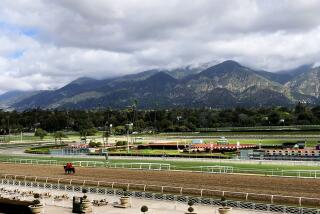This Corral Is More Than OK
- Share via
A clubhouse and swimming pool, miles of manicured trails, a 24-hour video monitoring system and a helipad for last-minute getaways. Sounds like a luxurious day spa where the rich and famous go to unwind.
In fact, Hummingbird Nest Ranch is a home for horses.
Not just any horses, but specially bred show horses owned by wealthy entrepreneur David Saperstein and his wife, Suzanne, an accomplished equestrian, renowned collector of haute couture and driving force behind the 140-acre center tucked into a rugged canyon in Simi Valley.
Saperstein, who pioneered the radio traffic report, and his wife completed the center this spring, well in time to play host to an international horse-jumping championship for children in November. They are building a 14,800-square-foot, Spanish-style home on a gentle rise overlooking one of three horse rings on the boulder-strewn property.
The center was built for private use but will occasionally be open to the public for special events.
The Sapersteins originally had planned to build an equestrian center in Coldwater Canyon, which is closer to their 45,000-square-foot mansion in Holmby Hills, but neighbors balked. Their real estate agent told them about a run-down ranch in the Santa Susana Mountains that might fit the bill.
“I had never heard of Simi Valley before,” said Saperstein, steering a golf cart down a wood chip-covered path that winds through the estate. “The beauty of this place is the geography.”
Set in a bowl at the foot of the mountains, Hummingbird Nest Ranch was once home to Chumash Indians and later became part of El Rancho Simi. It went through various owners’ hands until the Sapersteins bought it in 1999.
The ranch includes 11 houses for staff members, eight guesthouses, three barns and various outbuildings, including a veterinary clinic and breeding center.
The couple restored the estate’s original brick home, built in the 1920s, which features a Mission-style bell tower, a swimming pool and a centuries-old eucalyptus in the frontyard. The family has been staying in the small house during weekend visits while the mansion is being built.
Saperstein said his family’s love of horses was reflected in the care and attention to detail that went into the estate’s design, which was overseen by his wife, who shows horses competitively around the world.
Saperstein, who does not ride, said he was particularly proud that the ranch generates its own water and power through an on-site well and a field of solar panels.
“Unlike a hospital or a school, a facility like Hummingbird Ranch is not essential, so it shouldn’t use up everyone’s resources,” Saperstein said, stopping his golf cart in front of the main barn.
They equipped the 25,000-square-foot building with an automatic watering system for the horses, a full kitchen for staff and a spacious tack room decorated with oversized Mexican pottery and upholstered benches under a high, wood-beamed ceiling. Instead of dirt or hay underfoot, rubber pavers absorb the sound of clomping horseshoes. A carefully calibrated air-filtration system absorbs odors from the more than two dozen horses that live at the ranch at any given time.
On a recent morning, staff members in green and white uniforms scrubbed down horses in the wash stalls, which are nearly as large as those at a self-service carwash.
“We love it here, “ said Suzanne Saperstein, interrupting a meeting with her staff in the barn’s conference room.
David Saperstein said he and his wife wanted to build the equestrian center, which is surrounded by undeveloped public parkland, because they wanted a safe, quiet place for their five children and four grandchildren to spend time together.
“It’s not unusual to have 15 kids out here for the weekend,” he said. “It keeps them busy, dealing with the animals.... It’s a much better way for them to spend their time than hanging out at the mall.”
Eventually, he said, he would like schoolchildren to visit Hummingbird Nest to see what a working ranch is like and to learn about horses.
“Most kids who live here have never seen a farm,” Saperstein said. “Horseback riding doesn’t have to be a rich man’s sport.”
His children have ridden in competitions around the world, and he is excited about playing host to the International Equestrian Federation’s Children’s International Jumping Final this fall. It will feature 32 riders ages of 12 to 14.
Saperstein will invite 250 firefighters from the Ventura County Fire Department and their families to the event to thank them for saving the ranch from October’s wildfires, which nearly surrounded the property.
As the wildfire jumped across the nearby Ronald Reagan Freeway, the department used Hummingbird Nest Ranch as a staging area for several days.
Firefighters from throughout the state rested at the ranch, eating donated meals, washing their clothes in the laundry room and taking an occasional dip in the pool. Out-of-the area firefighters who stayed at the ranch also will be invited, Saperstein said.
With its helicopter pad and small, man-made lake filled with runoff water, the equestrian center had just about everything fire officials needed to sustain their operations, he said. Pleased with the experience, Saperstein said he was negotiating with the Ventura County Sheriff’s Department to use the ranch as a training center.
Looking down on the green, landscaped canyon from a rocky promontory, Saperstein smiled.
“There’s no place like this in Southern California,” he said.
More to Read
Sign up for The Wild
We’ll help you find the best places to hike, bike and run, as well as the perfect silent spots for meditation and yoga.
You may occasionally receive promotional content from the Los Angeles Times.






